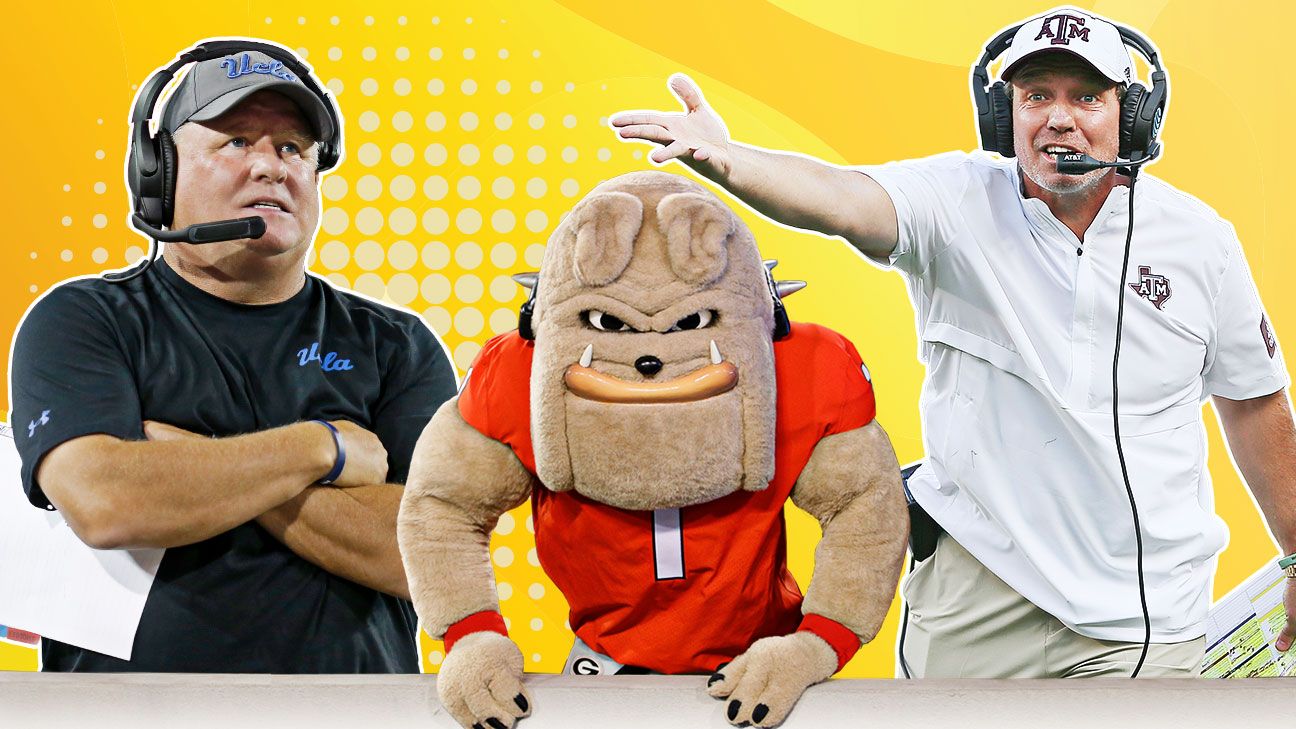Georgia is the inspiration for the underachiever tiers.
The last 40 years in college football have featured some surprising droughts, including extended lulls without conference championships for former powers Tennessee (1998), Nebraska (1999), Miami (2003) and Michigan (2004), and well-positioned programs such as Texas A&M (1998) and UCLA (1998). But I keep coming back to Georgia, a job many coaches consider the nation’s best and certainly in the top-five, but hasn’t won a national title since 1980, the year before I was born.
How does a program with Georgia’s natural advantages go four decades without winning it all?
There are certain programs in college football that just can’t seem to break through, at least not recently, despite some inherent traits (location, history, resources) that set them up for success. These are the teams that constantly prompt questions like, “Why can’t they win their league?” or “What happened to them?”
Not every underachiever should be expected to win a national title, or even to contend regularly for league titles or major bowl games. But there are groups of teams that should be achieving more than they are.
I’ve identified six tiers of underachievers, focusing on results from 1981 to 2020, but placing greater emphasis on the past 15-20 years.
Other than Georgia, teams that have made the College Football Playoff do not appear. I’ve also excluded any national title winners in the past 15 seasons.
Tier I: The Dawghouse

Full disclosure: I’m typing this while wearing a Georgia hat. I bought it during a 2018 trip to cover a game against Tennessee, my first-ever fall visit to Sanford Stadium. It was amazing. Everyone should see a game between the hedges. Georgia has it all — the stadium, the fan base, the finances, the town, the access to talent, the SEC. And yet a national championship continues to elude the Bulldogs.
Since 1980, when Herschel Walker helped the Vince Dooley-coached Bulldogs to a 12-0 record and a consensus national title, Georgia has been maddeningly unable to reach the sport’s pinnacle. The Bulldogs came so close in 2017 before Tua Tagovailoa broke their hearts in Atlanta, and might have won it all in 2012 if they got past Alabama in the SEC title game. But Georgia went 20 years without an SEC title, from 1982 to 2002, and owns only one league championship since 2005 (the Bulldogs do have six East Division titles since then).
They’ve clearly been close: Six AP top-10 finishes between 2002 and 2007, and six more since 2012 (including four consecutive top-seven finishes under coach Kirby Smart entering the 2021 season). But the inability to win just one national championship is baffling.
“It’s just something about that place,” a former Georgia assistant told me. “It’s a tough deal, but I think Georgia’s the best job in the country, period.”
Most coaches would line up to take Smart’s job, if available. Georgia is the flagship program in a top talent-producing state, located barely an hour from the Atlanta recruiting hub. Other than LSU, no SEC power is better positioned to dominate a region in recruiting, as Georgia Tech hasn’t consistently been a threat despite some stretches of success. Georgia offers strong academics, a fun college town and a strong tradition of producing NFL players.
Still, the list of national championship winners since 1980 includes almost every major program surrounding Georgia but Georgia — Clemson, Alabama, Florida State, Florida, Miami, Tennessee, and, of course, rivals Auburn and Georgia Tech. Georgia’s failure to win a title puts the program in a tier of its own.
TIER II: The I-10 Tier

Texas A&M: Texas A&M doesn’t enjoy quite as many advantages as Georgia, but its lack of championships might be even more shocking. The Aggies have gone twice as long without winning a national title (1939), and own just one league title since the Southwest Conference fell apart. Texas A&M can throw money at everything, as evidenced by coach Jimbo Fisher’s $75 million guaranteed contract and its sparkling facilities in College Station. There’s no major program located closer to Houston, a top national recruiting area. Fisher undoubtedly has the team on a promising trajectory, as Texas A&M finished No. 4 in 2020. But it marked only the Aggies’ second top-five finish since 1939. Texas A&M had only one AP top-10 finish between 1994 and last year.

UCLA: If there was a SimCFB game, you might build UCLA, a top public university with a broad and powerful tradition of athletic success, located in one of the nicest parts of Los Angeles. Anyone who has walked UCLA’s campus in Westwood knows that the place sells itself. And yet UCLA hasn’t won a conference title in 23 years! The Bruins have only two Pac-12 division championships, one AP top-10 finish and zero New Year’s Six bowl appearances during the span. There has been some laziness involved, as UCLA until recently had some of the worst facilities in the Power 5. The lack of an on-campus stadium hurts, but UCLA also plays its home games at the Rose Bowl, not some soulless NFL venue. Other than a stretch under coach Terry Donahue in the 1980s, UCLA hasn’t been a consistently relevant program.

Texas: I initially had Texas in the “lost-glory” tier of underachievers, but the Longhorns honestly belong here, alongside their old friends, the Aggies. Texas owns a national title in somewhat recent memory (2005), and actually won league titles during this millennium (2005, 2009). But the extended runs of mediocrity both before and after coach Mack Brown’s tenure enhance Texas’ status as an underachiever. The team has just one 10-win season since 2009, and has yet to make the CFP. Like UCLA, Texas is an elite public institution in a great location. Unlike UCLA, Texas isn’t lacking for resources and carries one of the most powerful brands in college sports. Texas is undeniably a top-five job. While also a complex job, Texas has no excuse not to win at a much higher level than it has been.
TIER III: Location, location, location
Well-located schools that can’t break through.
North Carolina, Arizona State, Maryland
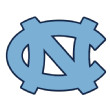
North Carolina: Mack Brown’s return to Chapel Hill has helped UNC flash its potential again — interestingly enough, Brown is the only coach to pry two programs on this list (North Carolina, Texas) out of underachiever status — but he can’t erase the past 20 years. UNC is a basketball school and always will be, but football should be much stronger there, given the local recruiting area, the appeal of the university and even some of its hoops connections such as the Jordan Brand. No conference titles since 1980 and only one ACC Coastal Division title is unacceptable. North Carolina has only two AP Top 25 finishes since 1997, which marked its last top-10 finish in the final year of Brown’s first go-round as coach.

Arizona State: In the 1970s, Arizona State emerged as college football’s newest Western power, recording five AP top-13 finishes, five Fiesta Bowl wins and a No. 2 final ranking in 1975 under coach Frank Kush. ASU recorded No. 4 finishes in 1986 and 1996, but no top-10s since and only four poll finishes since 1997 (none in the past six years). Despite an appealing location in a growing city, increased resources and a massive student body/alumni network, ASU remains the sleeping giant that can’t really wake up. The Sun Devils haven’t won a league title since 2007 and own only one South Division title (2013). Other than consecutive 10-win seasons in 2013 and 2014, they haven’t won more than eight games since 2007.
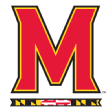
Maryland: Anyone who follows recruiting knows about the DMV — D.C., Maryland, Virginia — and the talent it produces annually. Maryland is the closest major program to the DMV region, located right outside the Washington city limits, and has had little trouble recruiting over the years. But the Terrapins have just one conference title since 1985, only one AP Top 25 finish since 2003 and no top-10 finishes since 1976. Other than a 31-8 stretch under coach Ralph Friedgen from 2001 to 2003, Maryland has eclipsed seven wins just three times since 1985. Maryland is a basketball-first school and has not invested enough in football until recently. But a school located so close to a major talent hub should deliver more success.
TIER IV: Lost-glory schools
Former national powerhouses turned underachievers.
Miami, Michigan, USC, Nebraska, Tennessee
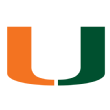
Miami: For more than 20 years, Miami was among the most dominant programs in college football, capturing five national titles. The Hurricanes recorded 15 AP top-10 finishes (12 top-five finishes) between 1981 and 2003. But the program has declined sharply since entering the ACC in 2004, despite being in a division opposite longtime rival Florida State and emerging power Clemson. Miami hasn’t won an ACC championship and owns only one Coastal Division title (2017). The Hurricanes have just six AP Top 25 finishes in the ACC and zero top-10 finishes. Miami is still located in one of the nation’s top recruiting areas, and the program has thrived at times in that area. There are some limitations with facilities and other areas, but Miami absolutely should be competing for ACC titles on a more regular basis.
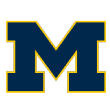
Michigan: Although Michigan didn’t contend nationally as often as Miami did in the 1980s and early 1990s, the Wolverines recorded eight AP top-eight finishes between 1983 and 1992, and won or shared seven Big Ten titles between 1982 and 1992. Michigan won a national title in 1997 and had five top-10 finishes between 1997 and 2006. But the program has become increasingly less competitive nationally and even in the Big Ten, where it hasn’t won a championship since 2004. The Wolverines have dropped eight straight games to Ohio State and beaten the Buckeyes just once since 2003. Michigan still prints money, carries a national brand and plays in the nation’s largest stadium. Although the past two decades have widened the gap between Michigan and national elites like Ohio State, the Wolverines should be performing at a higher level.

USC: Unlike others in this tier, USC owns a national title during this millennium, as well as a recent conference title in 2017. The Trojans won the Pac-12 South Division during a shortened 2020 season, and finished No. 3 with a Rose Bowl championship in 2016. But USC is one of the nation’s most storied programs, located centrally in one of the best recruiting markets. The Trojans have yet to make the College Football Playoff and recently have lost ground to Oregon in the Pac-12. Like Texas, USC has made only one truly successful coaching hire (Pete Carroll), as well as several administrative missteps. But USC has more inherent advantages than almost any other program, including several SEC powers. The Trojans should be consistent national players.

Nebraska: For decades, Nebraska was college football’s ultimate overachiever, winning five national titles and 16 conference titles between 1970 and 1997, despite playing in a sparsely populated Midwestern state. From 1969 to 2001, the Huskers finished every season ranked, and finished outside the top-15 only twice during the historic run. While such success likely was unsustainable given the changes in the sport, Nebraska had the ingredients (money, facilities, winning tradition, loyal fans) to remain a nationally relevant program and consistent league title contender. But after reaching three league title games in two conferences between 2009 and 2012, Nebraska has cratered, going 49-47 in the past eight seasons with four straight losing campaigns entering the fall. Many of Nebraska’s recent issues are covered here, but Huskers fans certainly deserve better.

Tennessee: The Vols finished in the AP top-10 every season from 1995 to 1999, including a national championship in 1998. They finished outside the AP top-15 just once between 1989 and 1999, and recorded a No. 4 finish in 2001. Although Tennessee lacked the direct recruiting advantages of some of its SEC rivals, the program had tradition, a massive stadium and more attributes to attract prospects to Knoxville. Consistent top-10 finishes seemed somewhat unlikely, but Tennessee projected as a Top 25 program. Instead, the Vols have finished ranked just twice since 2007, which also marked their final 10-win season. Making things more painful is the fact that Tennessee’s top rivals, Florida and Alabama, have combined for eight national titles since 2006.
Tier V: The Group of 5
Miami (Ohio), Houston, East Carolina

Miami (Ohio): The Mid-American Conference is delightfully unpredictable. Six different teams have won championships in the past six years, including Miami (Ohio) in 2019. Programs such as Northern Illinois, Toledo, Central Michigan and Ohio have had consistent runs of success. But ask coaches to identify the best job in the MAC and the answer is almost always Miami, a program rich in tradition (“Cradle of Coaches”) with strong resources and a true college environment. Miami has had its moments — league titles in 2019 and 2010, a No. 10 AP finish in 2003 behind quarterback Ben Roethlisberger, a 10-win season in 1998 — but also extended stretches of mediocrity or poor play. Since 2004, Miami has eclipsed six wins just twice, while posting five seasons of two wins or fewer (not counting 2020). Miami should be the MAC team creating the most regional and national buzz, but the program is often overlooked.

Houston: There’s a reason Houston keeps surfacing as a Big 12 expansion candidate (most recently at a Texas state senate hearing). It’s a large university in a major city and top recruiting market. Houston has invested greatly in athletics and especially in football. How many Group of 5 programs could lure away a sitting Power 5 coach (Dana Holgorsen) not on the hot seat? Houston has plenty of advantages that should put the program at the very top of the Group of 5. But other than brief but successful runs under Kevin Sumlin and Tom Herman, and three straight top-20 teams from 1988 to 1990, Houston has been average at best. Houston logged only three winning seasons between 1991 and 2005. While the program has been relatively solid since 2006, Houston is just 31-27 since 2016 and only 7-13 under Holgorsen. The results aren’t matching the investment.
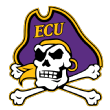
East Carolina: Those who have visited Dowdy-Ficklen Stadium when ECU football is rolling know it’s one of the best college football environments on the East Coast. ECU boasts a large and loyal fan base, albeit one that feels discouraged by recent results. Still, the program is located in a solid recruiting area, and has established its own true identity, separate from the ACC schools in the state. But other than a solid run from 2006 to 2014, when ECU averaged 7.8 wins with one 10-win campaign in 2013, the program has struggled to break through. The Pirates have logged six consecutive losing seasons entering 2021, their longest extended downturn since the mid-1980s. But ECU also hasn’t strung together more than four winning seasons since the 1970s. The AAC move has been tough but ECU should be better.
Tier VI: Bowled over
Simply making bowl games is a challenge.

Illinois: In the last 20 years, Illinois has made a Sugar Bowl (2001 season), a Rose Bowl (2007 season) … and done very little else. The program is loaded with tradition — Red Grange, Dick Butkus, Jim Grabowski, Dana Howard and others — and has underrated support at a basketball-leaning school. Illinois is a great school with access to Chicago, St. Louis, Indianapolis and Louisville. No one expects Illinois to become Ohio State, and even Wisconsin and Iowa aren’t realistic models. But Illinois should be making the postseason more often than five times in the past 19 seasons.

Syracuse: There’s genuine football tradition at Syracuse, which won a national title in 1959 and, after a long run of independence, three consecutive Big East titles from 1996 to 1998. Syracuse recorded nine AP Top 25 finishes between 1987 and 2001, did not record a losing season during the stretch, and played in two Fiesta Bowls, an Orange Bowl, a Sugar Bowl and a Peach Bowl. Since 2001, the Orange have appeared in only five bowl games and had postseason droughts of five years and four years. They own only one AP Top 25 finish during the stretch, in their only season with more than eight wins (10-3 in 2018). Syracuse is a basketball school not located near many top recruiting markets, but the program could achieve more than it has lately.

Cal: This one cuts deep for me, as I fell in love with college football at Cal games in the 1990s and even was a season-ticket holder for a few years. Like UCLA, Cal is an elite public school in a state packed with football players and located in a major market. Like UCLA, Cal long neglected its program financially and still struggles with resources/investment. Cal has some distant history of success, including three consecutive Rose Bowl appearances and AP top-five finishes from 1948 to 1950. But the school would make only two bowl games during the next four decades before a renaissance in the early 1990s. Cal had a solid stretch under Jeff Tedford, reaching seven consecutive bowls from 2003 to 2009 with two 10-win seasons. But since then they’ve made only four bowls and logged seven losing seasons.
